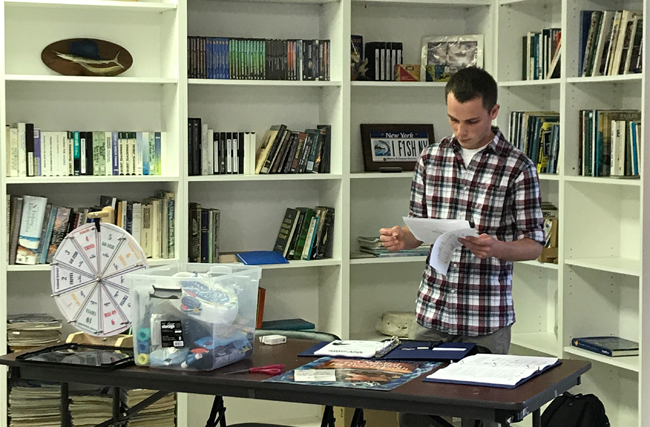
In Summer 2017, Jack Novack (pictured above) helped to design "Seafood Science and Aquaculture Lesson Plans" with NYSG Seafood Specialist Michael Ciaramella. Novack served as a NYSG intern funded through Cornell Cooperative Extension. Credit: Jack Novack, Michael Ciaramella/NYSG.
Contacts:
Michael Ciaramella, NYSG’s Seafood Specialist, E: mc2544@cornell.edu, P: (631) 632-8730
Stony Brook, NY, June 7, 2018 – Michael Ciaramella, New York Sea Grant’s (NYSG) Seafood Specialist, has designed Seafood Science and Aquaculture Lesson Plans, with help from Jack Novack, an intern funded through Cornell Cooperative Extension at Cornell University. The curricula serve as outlines introducing seafood science and aquaculture topics to students. Lesson plans accompanying the curricula guide specific classroom activities to engage students with aquaculture and seafood science materials.
Every year the federal government invests millions of dollars into research advancing the aquaculture industry in the United States. Last October, for example, the National Oceanic and Atmospheric Administration (NOAA), Sea Grant’s federal parent agency, announced $9.3 million in support of Sea Grant aquaculture research nationwide.
But the industry also needs trained professionals to operate those facilities and these lesson plans are designed to introduce students to a great career opportunity. Jobs will increase as the industry starts to expand—and the need for workers with a knowledge of aquaculture and seafood science will increase.
“Seafood science and aquaculture is not something typically taught to middle and high school students or younger, so we wanted to try and get a curriculum developed that can easily be incorporated into the lesson plans of teachers throughout the state,” said Ciaramella.
Before exploring the world of seafood science, the Seafood Science Curriculum (pdf) introduces the basic components of general food science. Then, the material dives into specific topics within the seafood science discipline. The curriculum explains the four “P’s” of seafood science: how to produce, preserve, protect, and perfect seafood and seafood resources.
The Aquaculture Curriculum (pdf) introduces basic information on aquaculture practices and key considerations for fish farmers, while touching briefly on issues surrounding seafood security. Such lessons invite students to consider what factors shape the decisions fish farmers make when selecting a species to farm, system to employ, what to feed the fish and how to maintain good water quality to ensure quick and efficient growth of healthy seafood.
A lesson plan titled “A Spin on Seafood” (pdf) engages students by utilizing a spinning wheel with five trivia categories: Fisheries, Aquaculture Seafood Science, Seafood Sustainability, Seafood Safety, and five other go fish sections. The activity serves as a great starting point for discussion of seafood science, fish biology, sustainability, conservation, and a variety of other seafood topics.
The “Becoming a Fish-Farmer” (pdf) lesson plan is a hands on creative activity that requires students to think outside the box to create their own miniature aquaculture farm. A background scenario entices students to create an effective dynamic model of their own farm system.
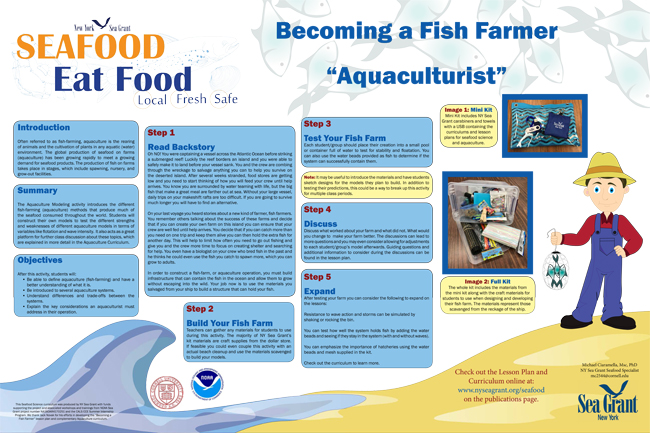
Often referred to as fish-farming, aquaculture is the rearing of animals and the cultivation of plants in any aquatic (water) environment. This NYSG outreach poster, "Becoming a Fish Farmer Aquaculturist" (pdf), outlines the process. Credit: Michael Ciaramella/NYSG.
The curricula will not only benefit students interested in a career in aquaculture, but it will also provide valuable education for future consumers of farmed fish. The curriculum will make kids familiar with the aquaculture industry, which will help dispel misconceptions about farmed fish and in turn increase the potential consumer base of farmed fish.
“When it’s done right, farmed fish is safe and healthy, it’s just as good as the wild caught species. In addition to developing a workforce, it’s important to dispel some of the myths surrounding aquaculture so that there’s a market for farmed product as we grow and expand the industry. This industry needs not only workers, but also people who are happy and willing to consume that product,” Ciaramella said.
Ciaramella has collaborated with classrooms implementing the curricula and lesson plans, which are available as free resources to teachers at www.nyseagrant.org/seafoodpublications.
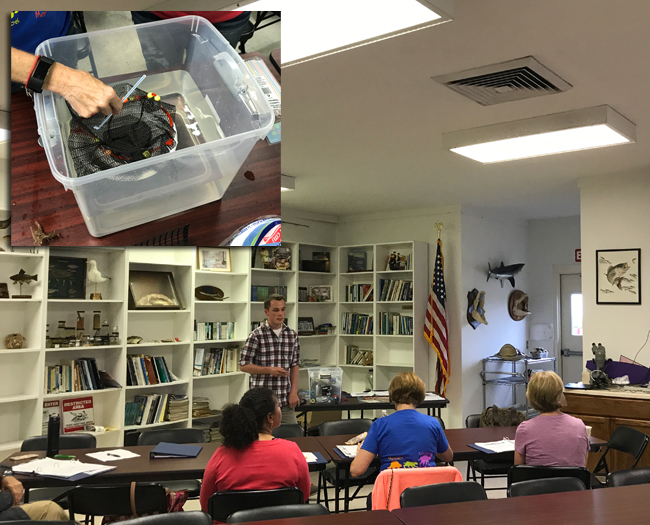
More Info: Additional NYSG "New York Sustainable Seafood Resources"
These seafood sustainability resources below were produced by NY Sea Grant with funds supporting the publication and associated workshops and trainings from NY Sea Grants Program Development funds and NOAA Sea Grant project number NA16OAR4170251.
These and additional resources are in NYSG's "Seafood Safety & Technology" resource site's "Publications" section, www.nyseagrant.org/seafoodpublications.
- Booklet: Sustainable Seafood Guidance (pdf)
This booklet outlines the general criteria used in assessing sustainability by some of the larger 3rd party certifiers and comparing these criteria to current regulations. The guide is meant to provide some more detailed information on seafood sustainability and how uncertified fisheries, farms or fishermen compare to certified fisheries through regulatory compliance. The guide also discusses some of the underutilized species that are available in NY. The resource is meant to provide more information for consumers and help the industry make decisions with regards to sustainably grown, harvested and sourced seafood in the state. While the document was geared towards NY businesses and residents much of the information provided on 3rd party certifiers and federal regulations are applicable across state lines.
- Brochure: Seafood Label Guide for NY (pdf)
This trifold outlines some of the sustainability labels that can be found on seafood products sold in NY. Information on the different certifying bodies are included and some information on local fisheries. This resource is meant to help consumers identify and choose sustainable seafood.
- Infographic: New York Seafood (pdf)
This infographic outlines the benefits of NY Seafood and provides a visual depiction of many of the species available locally.
- Comparison Card: State & Federal Regulation vs. Third Party Sustainability Certifiers (pdf)
This card provides a quick and general comparison of 3rd party certifications and government regulations. This general overview is meant to be a starting point for consumers and the industry to understand how sustainable fisheries are managed and the different organizations involved. This resource provides a general overview of what is provided in greater detail in the Guidance Booklet.
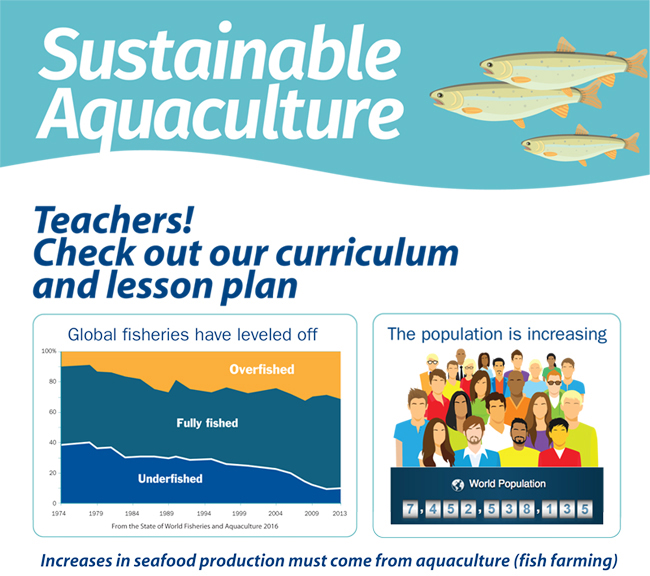
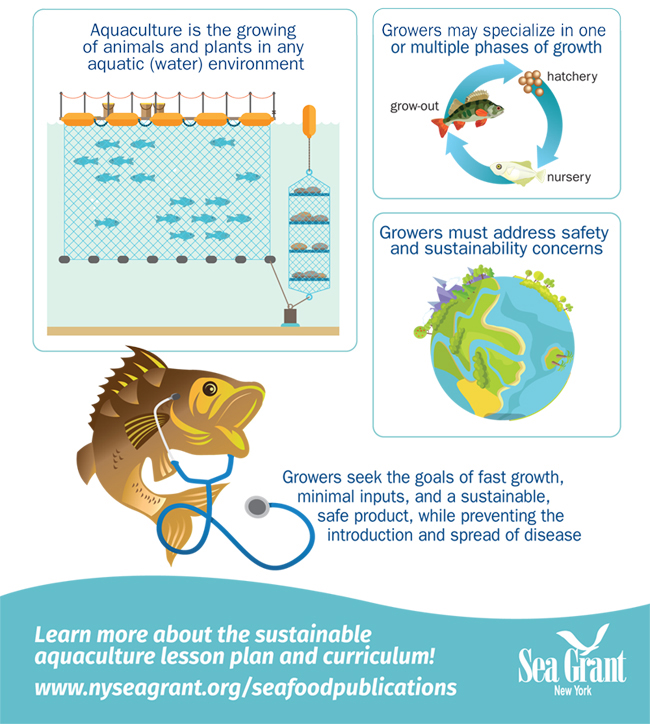
As illustrated in the "Sustainable Aquaculture" (pdf) poster above, NYSG's seafood science and aquaculture curriculum and lesson plans are resources that teachers can use to incorporate the topics into their classroom learning. Credit: Loriann Cody (design); Mike Ciaramella, Chris Gonzales (concept, editing).
More Info: New York Sea Grant
New York Sea Grant (NYSG), a cooperative program of Cornell University
and the State University of New York (SUNY), is one of 33 university-based
programs under the National Oceanic and Atmospheric Administration’s
National Sea Grant College Program.
Since 1971, NYSG has represented a statewide network of integrated
research, education and extension services promoting coastal community
economic vitality, environmental sustainability and citizen awareness
and understanding about the State’s marine and Great Lakes resources.
Through NYSG’s efforts, the combined talents of university scientists
and extension specialists help develop and transfer science-based
information to many coastal user groups—businesses and industries,
federal, state and local government decision-makers and agency managers,
educators, the media and the interested public.
The program maintains Great Lakes offices at Cornell University, SUNY
Buffalo, SUNY Oswego and the Wayne County Cooperative Extension office
in Newark. In the State's marine waters, NYSG has offices at Stony Brook
University in Long Island, Brooklyn College and Cornell Cooperative
Extension in NYC and Kingston in the Hudson Valley.
For updates on Sea Grant activities: www.nyseagrant.org has RSS, Facebook, Twitter, and YouTube links. NYSG offers a free e-list sign up via www.nyseagrant.org/nycoastlines for its flagship publication, NY Coastlines/Currents, which is published quarterly. Our program also produces an occasional e-newsletter,"NOAA Sea Grant's Social Media Review," via its blog, www.nyseagrant.org/blog.